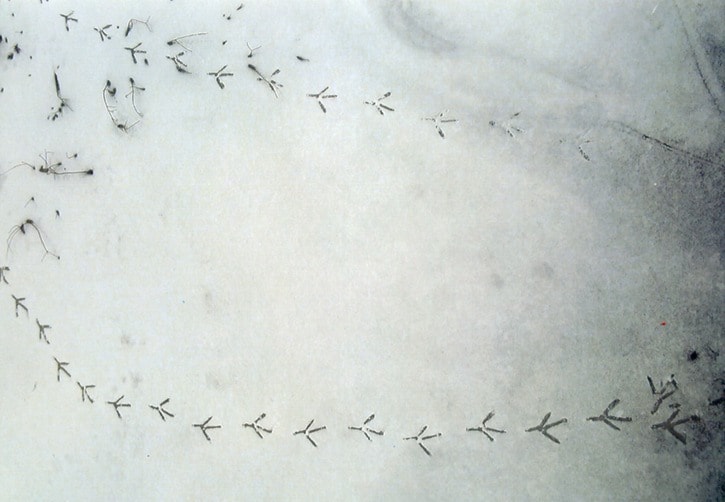One of the best times in winter to find animal and bird tracks is when there has been a fresh, light snowfall over a firm base of dirt, ice or snow. The detail of a larger footprint is at its best, often clearly showing not only the toes but also the toenails or claws. Of course, if the print is of a member of the cat family the claws won’t show much or at all unless the animal is running or scrambling. However, with members of the dog clan, the claws distinctly show most of the time on any kind of impressionable surface.
With the recent dropping of the snow level to lower valley slopes and bottom land, you will see more evidence of animal travels, especially of deer, who will come down to avoid the deep snow of higher levels and show up closer to human habitation. You can expect to find more tracks. Coyotes find hunting more successful where there is shallower snow cover. It is easier to maneuver in and, also, small mammals like mice are more visible. For us, determining in deep snow what creature made the track is more difficult because the snow often falls into the track covering the print. But then, the creature that made the track can be identified by other means like the gait, length of step, size of print, habit and so on.
I find it interesting to follow a set of animal tracks. Ruffed grouse tracks are quite common along forest edges and on brushy slopes. Their trails look like continuous strings of crosses formed by the forward toe print almost connecting with the back of the other footprint. The trail can be very zigzag as the bird moves here and there feeding on dormant winter buds of small evergreens and deciduous shrubs and feeding on the occasional hibernating insect. One may have to crouch down to see what direction the bird took. One may even find the spot where the grouse launched out of the fresh snow when avoiding your too-close approach.
A part of winter ecology is the natural snow sheds that add diversity to the forest winter landscape. When snow falls on evergreen trees, it sits on the branches until it melts or sublimates, vaporizing without first becoming moisture. The snow on the branches weighs the branches down so that when it begins to melt it slides down the branch, falling to the ground away from the tree trunk. Thus, the ground under the tree seldom gets much snow, leaving ground vegetation exposed for grouse to forage and for winter shelter. In the alpine it also leaves a pit, a tree well, for a skier to fall into.
It is possible to find trails of voles, shrews and jumping mice in the snow. Sometimes the snowfall can be so light that it doesn’t support even the weight of a shrew. So the evidence that “somebody” passed that way is a little snow trench bulldozed through the snow. Zapus princeps (western jumping mouse) doesn’t have to plow through the snow. The snow challenge is met by just jumping along over it. In a snowy coniferous forest you might find yourself on the trail of one of these. These small mammals, for the most part, travel next to the ground under the protective snow cover by way of a network of tunnels pushed through the snow. Recently, someone was scraping away the snow from below a bird feeder when they exposed a vole dining on seeds fallen from the feeder.
Tracks of large animals may be more numerous around where there is water or plenty of some favourite food. Winter forage is often great for moose and elk where there are lots of deciduous shrubs like willow, aspen and red-osier dogwood. Moose will come down in winter and wander from shrub to shrub or from one shrubby thicket to another. I have often wondered how they, wandering about, can make so many tracks but they are at it all the time, when they are not sleeping or resting, slowly moving along and feeding here and there. They also have two pairs of feet, not one pair. Their large hooves make the largest footprint you will likely find in the wild, except those of a packhorse. You may find a large smooth hollow in the snow where they bedded down or you may see their large oval droppings. Even though moose will often seek secluded lower places with shallow snow cover they are very capable of nonchalantly wandering around in winter at higher elevations through four feet of snow.
I have seen some pretty distinct animal footprints and wished that I had some plaster of paris along with a little water to mix and pour into a footprint, making a reverse print. At home I would make a casting of the reverse print and have an actual life-sized copy of, say, a wolf, cougar or moose footprint. I would paint it the color of the mud and tell you I got a cougar to step in this and leave a track. (I needed to tell you something you would believe.) This is a little bit of fun that can be a learning experience. Try it next summer when it’s hopefully warm enough for the plaster of paris or drywall filler to set. Then you can introduce people, who are unable to get out there, to a footprint of a coyote or other creature.
Ed McMackin is a biologist by profession but a naturalist and hiker by nature. He can be reached at 250-866-5747.
